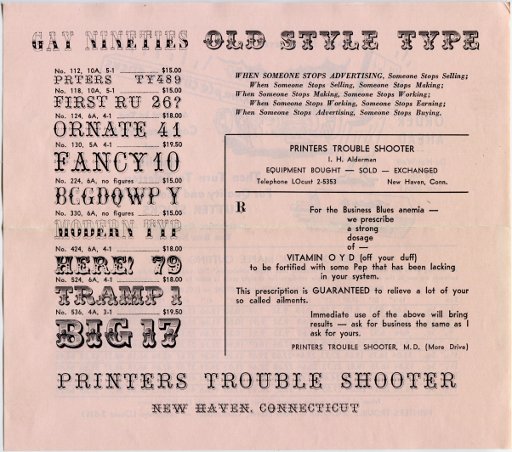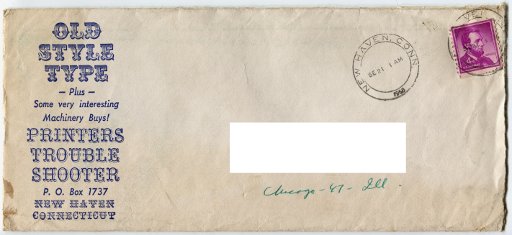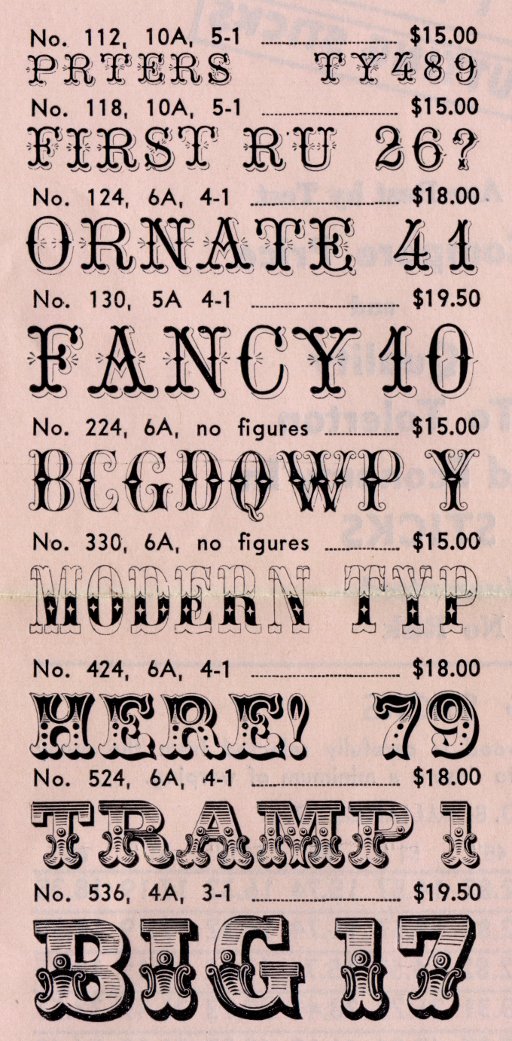As I write this in early 2011, I do not have any showing of types that I know for certain were cast by Harry Weidemann. However, it is possible (but by no means certain) that this specimen is of types by Weidemann.
Before going on, though, I cannot help but make one observation. These types were, as this specimen indicates, the beginning of a revival of "Gay Nineties" typeface in the US. The only problem, of course, is that the typefaces themselves have nothing at all to do with the 1890s. They are more characteristic of the 1840s to 1860s (the face in which "Gay Nineties" is printed in this specimen dates to 1830). But Americans have never had any real sense of time; this is perhaps why we plan so poorly for the future. Already by the 1950s, when people who were adults in the 1890s were still alive, we had fabricated an entirely fictitious "gay nineties" out of 1840s typefaces and a Wild West mythology.
In any event, here is an advertising flyer issued in 1958 by "Printers Trouble Shooter," a used and new printing equipment dealer. (The back of the flyer, and other flyers enclosed with it, simply advertise printing equipment for sale.)

(The image above clicks through to a more than sufficient 2048 pixel wide JPEG. In the interests of archival completeness, however, here is the original 1200 dpi scan: printers-trouble-shooter-gay-nineties-old-style-type-flyer-1958-1200rgb-recto-rot90cw-crop-9647x8514.png. It is 108 Megabytes, though, so you probably don't really want it.)

Each of the five typefaces is identified by a three-digit number. I believe that the second two digits indicate the body size of the type in points, while the first digit indicates the type series number. In four of the five cases, at least, this first digit corresponds to the numbering of the typeface in one of the alternative namings of these types, "Ornate No. N".
The first of these series, Nos. 112, 118, 124, and 130, is better known as Tuscan Graille or Stellar (but not to be confused with R. Hunter Middleton's Stellar for Ludlow). McGrew (p. 344) identifies it as a Weidemann typeface, Weidemann's no. 130. In tracing its origins, McGrew further indicates that it is a copy of either the Cincinnati Type Foundry's Ornamented No. 22J or Bruce's New York Type Foundry's Ornamented No. 1046. He places these circa 1860.
While I cannot seem to find this face in the Cincinnati Type Foundry's Specimen and Price List of 1870, four versions are shown in the 1877 Cincinnati Type Foundry catalog page of Fancy Type reproduced on p. 108 of Annenberg's Type Foundries of America and their Catalogs (1975) : Two-Line Brevier Ornamented, No. 11J, Two-Line Small Pica Ornamented, No. 20J, Two-Line English Ornamented, No. 24J, and Two-Line Great Primer Ornamented, No. 22J.
I have not yet found a showing of Bruce's Ornamented No. 1046, but the same face appears in four sizes as Two-Line Brevier Ornamented, No. 7, Two-Line Long-Primer Ornamented, No. 19, Two-Line Pica Ornamented, No. 40, and Two-Line Great-Primer Ornamented, No. 27 in An Abridged Specimen of Printing Types Made at Bruce's New-York Type-Foundry . (New-York: George Bruce's Son & Co., 1869.) .
An examination of Nicolette Gray's XIXth Century Ornamented Types and Title Pages. First Edition. (London: Faber and Faber Limited, 1938) shows it as a face by Caslon, circa 1865 (revived 1884). ( Gray's Catalog No. 190, p. 204).
This face is not attested in the Typefounders, Inc. [of Phoenix] 1962 Specimen 7A. Neither is it attested in the Los Angeles Type Founders 1961 Specimen No. 17. It is, however, show in an LATF specimen from the mid 1970s. This would seem to indicate that the Weidemann matrices passed either to Typefounders, Inc. [of Phoenix] or to LATF at some point between these terminal dates.
The matrices for Tuscan Graille in all four sizes shown here passed from LATF to Barco / F&S and are presently owned by Skyline Type Foundry.
From the point of view of typeface identification, No. 224 may be the most interesting one shown here. It is the face identified by McGrew as Ornate No. 2, Romantiques No. 3, or Harmony. Of the face from which it was copied, McGrew says only that it was "about 1850" (with no futher identification). He does, though, explicitly attribute this copy to Weidemann.
It is unattested in any of the Phoenix or LATF specimens presently at my disposal: Typefounders, Inc. [of Phoenix] Specimen 7A, LATF Specimen No. 17, or an LATF specimen from the mid 1970s.
It is not in the inventory of Skyline Type Foundry, and so either was never possessed by Typefounders, Inc., LATF, or Barco/F&S or was lost at some point.
No. 330 is Tuscan Outline, identified by McGrew as Ornate No. 3, Romantiques No. 1, Carnet du Bal, and Uncle Sam. McGrew does not explicitly associate this face with Weidemann. He traces it to Bruce's New York Type Foundry's Ornamented No. 851, itself a copy of Laurent & Deberny's Ornamented No. 1071 of about 1830.
This face also appears as [Two-Line Pica] Ornamented, No. 24 ( Bruce) in An Abridged Specimen of Printing Types Made at Bruce's New-York Type-Foundry . (New-York: George Bruce's Son & Co., 1869.)
This face also appears as [Two-Line Pica] Ornamented, No. 20 ( Cincinnati) in the Cincinnati Type Foundry's Specimen and Price Lists of 1870. However, it does not appear in their 1882 specimen (not even in the Price List for 1882).
As Tuscan Outline, the Twentieth Century version is attested in Typefounders, Inc. [of Phoenix] Specimen 7A in 18, 24, and 30 point. In LATF Specimen No. 17 it is shown in 30 point only. In an LATF specimen from the mid 1970s it is shown in 18, 24, and 30 point.
The Skyline Type Foundry inventory lists it in 30 point only. I do not know the location of the 18 and 24 point matrices; they were either deaccessioned or lost by either LATF or Barco / F&S prior to the acquisition of that lineage by Skyline.
No. 424 is Tuscan Ombree. McGrew identifies it also as Ornate No. 4, Romantiques No. 2, or Carnival. He does not explicitly associate this face with Weidemann (but neither does he associate it with anyone else; he simply says nothing about its maker). For the main entry on the various incarnations of this face, see Tuscan Ombree.
As Tuscan Ombree, this face has the following known provenance: Typefounders, Inc. [of Phoenix] Specimen 7A attests it in 24 point and notes that 18 point is in preparation. LATF Specimen No. 17 (1961) and an LATF specimen from the mid 1970s attest it in both sizes. It is not clear (to me, at least) whether the LATF 1961 type was cast by them or by Phoenix. The matrices for this face were acquired in 2010 from Barco / F&S (successors to LATF who had, in turn, acquired Typefounders, Inc. [of Phoenix]) by Skyline Type Foundry. The Skyline matrix inventory shows them in both 18 and 24 point.
Nos. 524 and 536 are Tuscan Ornate. McGrew cross-identifies this as Ornate No. 5, Romantiques No. 5, and Bracelet. Of its origins he says only that it is an "English design of about 1850."
However, the design in Nicolette Gray (1938) which most resembles it is her Catalog No. 211, attributed to Figgins, circa 1870 (p. 205).
Typefounders, Inc. [of Phoenix] Specimen 7A attests it in 24 point and notes that 18 point is in preparation. LATF Specimen No. 17 and an LATF specimen from the mid 1970s attest it in both sizes. The Skyline Type Foundry matrix inventory shows it in both 18 and 24 point.
Finally, here they all are in a single handy image (click for a 21 Megabyte full-resolution version):

All portions of this document not noted otherwise are Copyright © 2011 by David M. MacMillan and Rollande Krandall.
Circuitous Root is a Registered Trademark of David M. MacMillan and Rollande Krandall.
This work is licensed under the Creative Commons "Attribution - ShareAlike" license. See http://creativecommons.org/licenses/by-sa/3.0/ for its terms.
Presented originally by Circuitous Root®
Select Resolution: 0 [other resolutions temporarily disabled due to lack of disk space]